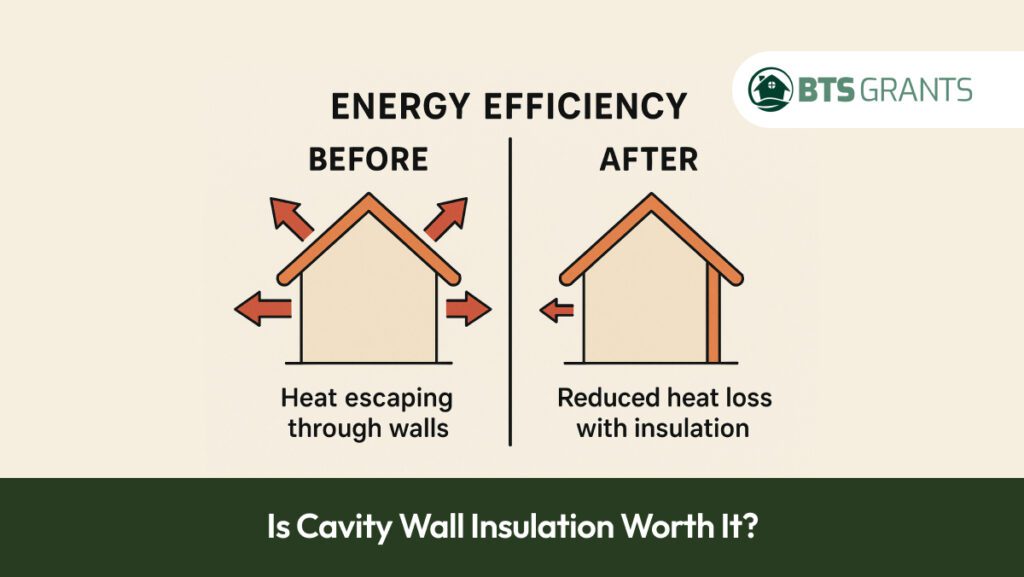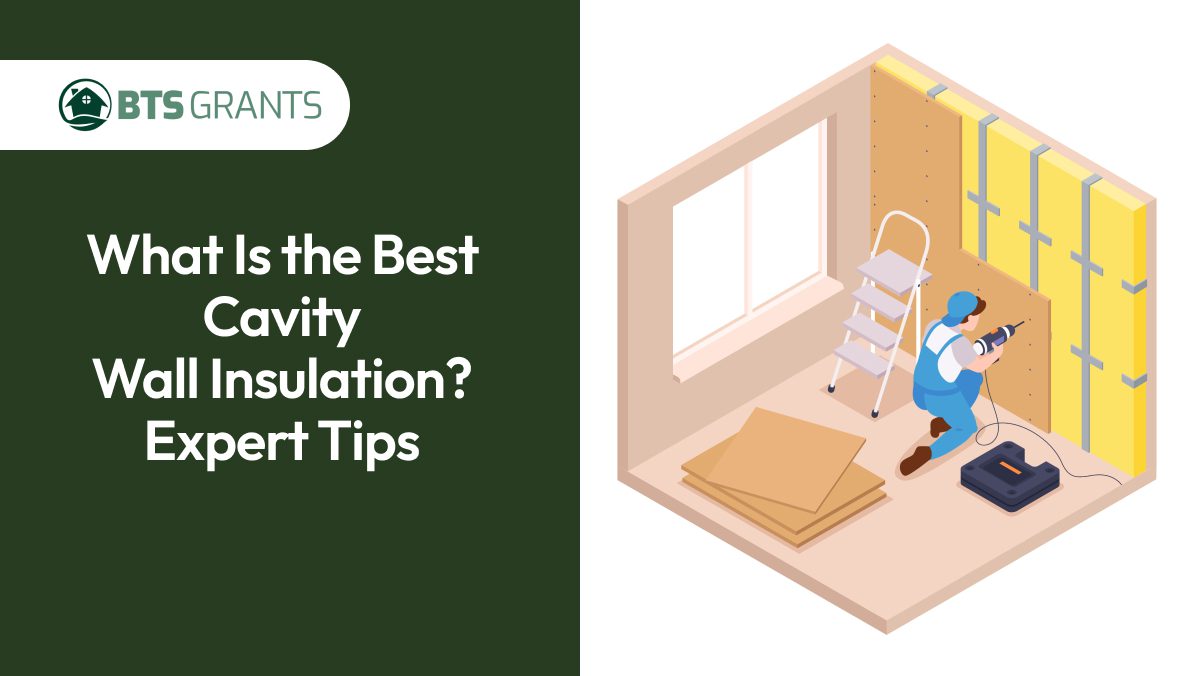Choosing the right cavity wall insulation is one of the biggest steps you can take to improve house insulation, cut heating bills, and prevent damp. But because there are several materials on the market—each with its own strengths and weaknesses—homeowners often wonder:
- What is the best cavity wall insulation?
- Is cavity wall insulation worth it?
- Which type works best for old houses?
In this guide, we’ll explain all 7 of the best cavity wall insulation materials, help you understand cavity wall insulation types, and show you which option is most suitable for your home.
What Is Cavity Wall Insulation?
Cavity wall insulation refers to the material inserted into the gap between the inner and outer walls of the property. By nature, this cavity can allow easy heat escape, especially in older properties with poor insulation.
Adding the right insulation aids with:
- Lower energy bills
- Better indoor comfort
- Reduced heat loss
- Moisture control
In other words, insulation for cavity walls warms up your house and makes it more efficient.
Why Choosing the Right Insulation Matters
Choosing the wrong type of insulation can cause:
- Damp problems
- Condensation
- Cold spots
- Decreased efficiency
That is why it is important to understand the cavity wall insulation types. The best material keeps your home warm, avoids damp, and lasts for decades.
If you are worried about moisture, choose the right cavity wall insulation to avoid damp.
7 Best Types of Cavity Wall Insulation


1. Mineral Wool (Rockwool / Glass Wool)
Mineral wool is one of the most popular choices for UK homes, and it’s easy to see why.
Pros
- Breathable (reduces damp risks)
- Fire-resistant
- Affordable
- Excellent thermal performance
Cons
- Not suitable for very narrow cavities
- Ideal for walls in good condition
Due to its breathability, mineral wool is mostly considered recommended cavity wall insulation, particularly for older homes.
2. Polystyrene Beads (EPS Bead Insulation)
One of the most modern and efficient cavity wall insulation options is EPS beads.
Pros
- Excellent thermal insulation
- Performs well in moist weather conditions
- Spreads evenly inside the cavity
- Long-lasting
Cons
- Not suitable for walls with debris inside the cavity.
Most installers agree that EPS beads constitute the best cavity insulation in standard UK homes.
3. Urea-Formaldehyde Foam (UF Foam)
This type of foam was commonly used in the 80s and 90s, but has become less common today.
Pros
- Expands to fill gaps
- Good for narrow cavities
Cons
- Can degrade over time
- Absorbs moisture
- Mostly removed and replaced with modern insulation
An extraction may be recommended if your home still has UF foam.
4. Polyurethane Foam (PU Spray Foam)
Spray foam insulation is popular for roofs and lofts, but not widely advised for cavity walls.
Pros
- Very high insulation value
Cons
- Can trap moisture inside the wall
- Hard to remove
- Not mortgage-friendly
- Can block ventilation
This is not typically recommended for cavity wall insulation unless advised by a specialist.
5. Specialist Pumped Systems (High-Breathability Fibre Options)
These include advanced fibre-based materials suitable for hard-to-treat cavities or older homes.
Pros
- Breathable
- Good for damp-prone properties
- Designed for old wall structures
Cons
- Available only through specialist installers
- Not suitable for all cavity widths
These systems are widely used when homeowners need best cavity wall insulation old house.
6. Phenolic Foam Boards (Rigid Insulation Boards)
Phenolic boards boast excellent thermal performance and are used in many external wall refurbishments and new builds.
Pros
- High thermal efficiency
- Thin but highly effective
- Moisture-resistant
Cons
- Cannot be injected into existing cavity walls
- Very expensive
- Requires access to the cavity through partial wall removal
Perfect for major renovation projects or insulation replacement.
7. PIR (Polyisocyanurate) Boards
PIR boards are widely used in modern construction and refurbishment.
Pros
- Strong thermal performance
- Durable and long-lasting
- Good for partial-fill systems
Cons
- Not suitable for traditional cavity wall installs
- Must be installed during major works
This is commonly advised where old insulation is replaced during renovation.
Cavity Wall Insulation Comparison Table (Performance, Cost & Lifespan)
To help you compare performance, cost, and durability at a glance, here’s a quick breakdown of the seven most common cavity wall insulation materials.
| Insulation Material | R-Value (per inch) | Typical Lifespan | Estimated Cost per m² (£) | Installation Complexity |
| PIR (Polyisocyanurate) Boards | 6.0 – 7.2 | 50+ years | £25 – £35 | Medium |
| Phenolic Foam | 7.5 | 20 – 25 years | £30 – £40 | Medium |
| Spray Foam (Closed-Cell) | 6.0 – 7.0 | 25+ years | £35 – £45 | High |
| Mineral Wool | 3.0 – 3.7 | 25+ years | £15 – £25 | Low |
| Polystyrene Beads / Boards | 4.0 – 4.5 | 30+ years | £20 – £30 | Low |
| Polyurethane Foam | 5.5 – 6.5 | 30+ years | £30 – £40 | High |
| Cellulose | 3.2 – 3.7 | 20 – 30 years | £15 – £25 | Medium |
Every home is different. Some materials are better for damp walls, while others are great at keeping your home warm. Knowing the differences helps you pick the right fit.
What Is the Best Cavity Wall Insulation? (Expert Suggestions)
The following are recommended by experts according to their effectiveness, resistance to moisture, and ease of installation:
Best Overall: EPS Polystyrene Beads
Perfect for most homes and climates.
Best for Older Houses: Mineral Wool
Because it’s breathable and a safer choice for aging structures.
Other materials, such as phenolic foam and PIR boards, perform well, but are mainly suited to large-scale refurbishments rather than simple cavity fills.
Best Cavity Wall Insulation for Old Houses
Older houses often have more delicate walls, higher damp risks, or uneven cavities.
The safest choices are usually:
- Mineral Wool (breathable)
- Specialist high-breathability fibre systems
EPS beads may also work — but only after a full cavity inspection confirms it’s safe.
This is important when selecting the cavity wall insulation for an old house.
Is Cavity Wall Insulation Worth It?


Yes — for most properties, homeowners see:
- Lower energy bills
- Less heat loss
- Reduced carbon footprint
- A warmer home
This answers the common question: Does cavity wall insulation save energy?
Absolutely.
How Much Does Cavity Wall Insulation Cost?
The price of insulation varies depending on your home’s size and the type you choose
- Terraced home: £800–£1,200
- Semi-detached: £1,000–£1,800
- Detached: £1,800–£3,000
Grant funding through schemes like ECO4 is also available.
What Houses Should NOT Have Cavity Wall Insulation?
Avoid cavity wall insulation if your home has:
- Existing damp
- Very narrow cavities
- Rubble, debris, or contamination inside cavities
- Porous brickwork exposed to wind-driven rain
- Cracks or defects in exterior walls
These factors can cause trapped moisture and damage.
Are There Grants for Cavity Wall Insulation?
Yes, in many cases, homeowners can get cavity wall insulation heavily subsidised or even fully funded through energy-efficiency schemes in the UK. These grants specifically aim to help eligible households reduce carbon emissions, lower energy bills, and enhance their home comfort.
Most Common Grant Options:
- ECO4 Scheme – Helps low-income and vulnerable households access free insulation, heating upgrades, and energy-saving improvements.
- Great British Insulation Scheme (GBIS) – Provides support for upgrades for those with EPC ratings from D to G; cavity walls included.
- Local Authority Delivery (LAD) Funding – Some councils offer free surveys and subsidised insulation for qualifying homes.
Who Can Qualify?
You may be eligible if:
- Your property has poor energy efficiency
- You receive certain government benefits
- Your income is below the threshold
- You live in a cold or hard-to-heat property
Even if you’re unsure, it’s worth checking—many homeowners qualify without realising it.
Conclusion
Cavity wall insulation plays a crucial role in ensuring warmth, comfort, and efficiency in your house. You must always have a professional survey to make sure the material you choose will be compatible with your house’s structure, whether it is breathable mineral wool, strong phenolic boards, or energy-efficient EPS beads.
Proper insulation means lower bills, a cosy home, and long-lasting comfort you can actually feel.
FAQs
For most homes, EPS beads are a top choice.
Yes — homeowners typically save hundreds annually.
Costs range between £800 and £3,000 depending on the house type.
Material is installed inside the cavity between brick walls to reduce heat loss.
EPS beads offer the highest performance for standard cavity walls.
Mineral wool or EPS beads are the safest and most effective.
Homes with damp, narrow cavities or high exposure to wind-driven rain.





